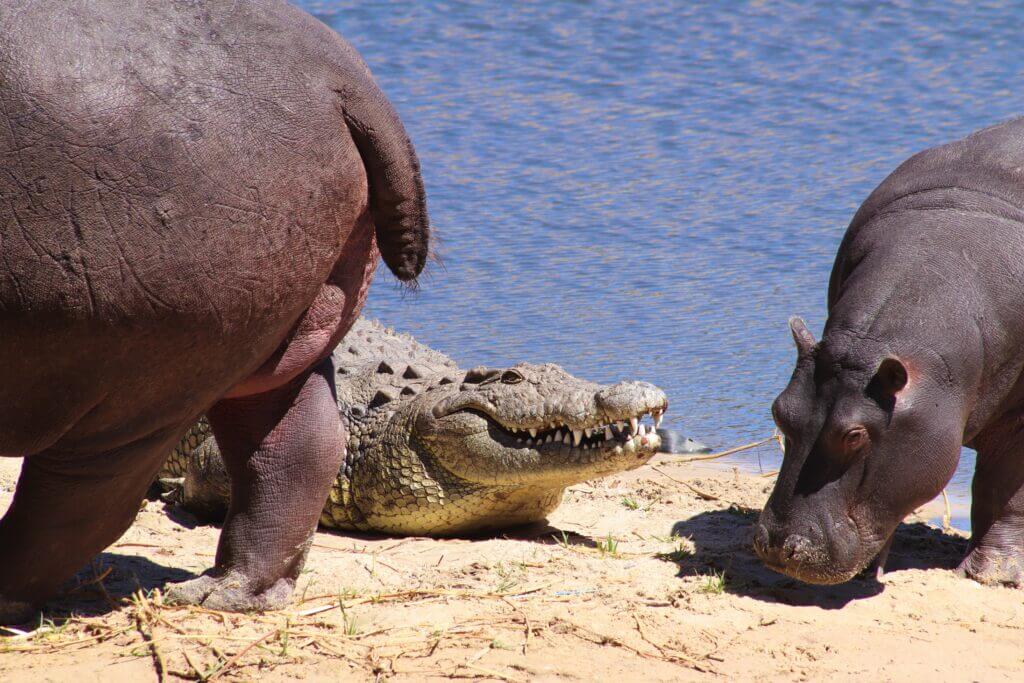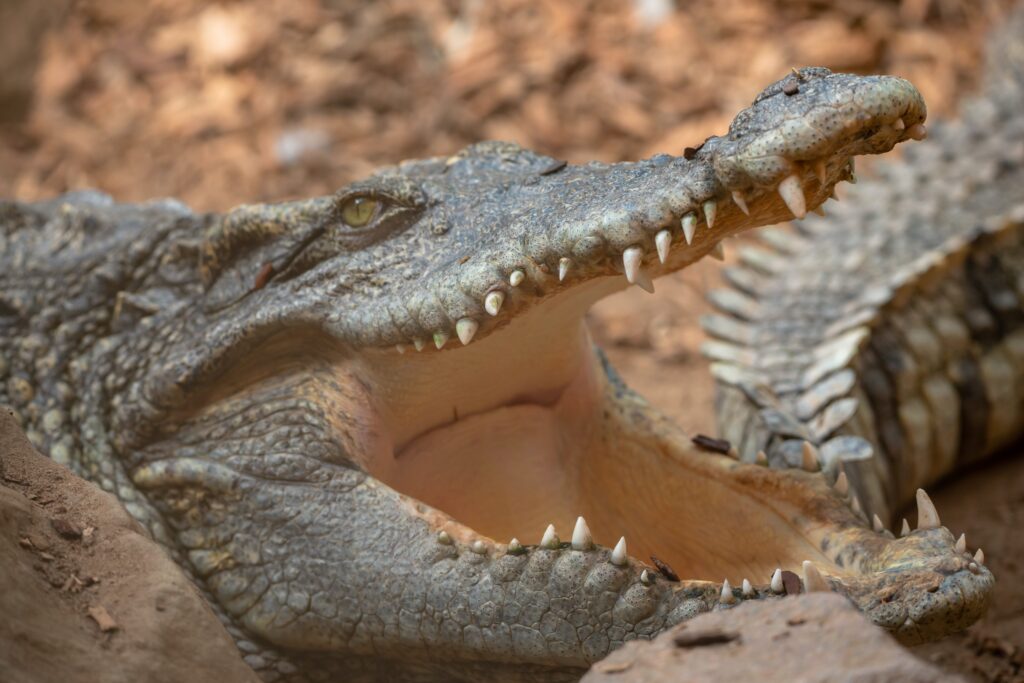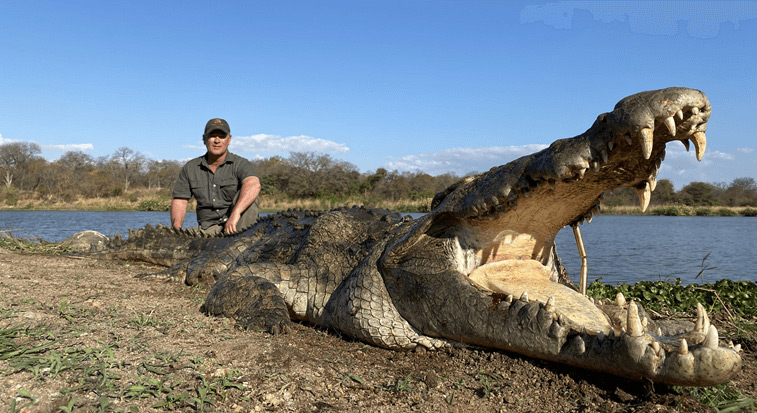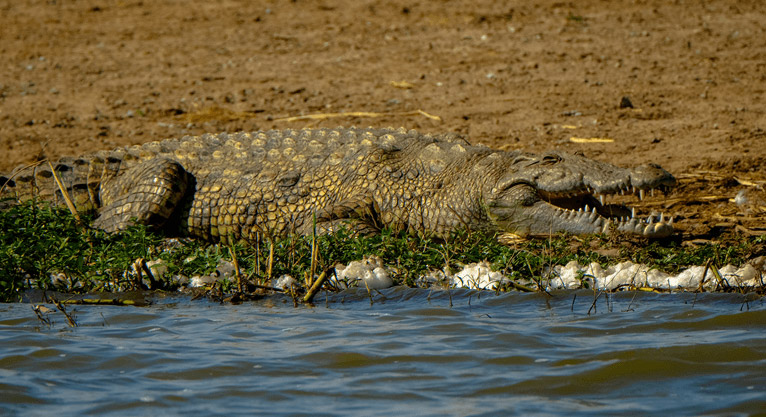[DYNAMIC-BLOGTABLEOFCONTENT]
What makes the ferocious Nile Crocodile an enticing choice for a Hunting Safari Experience?
Ferocious, angry, and always the opportunistic hunter when it comes to prey, the man-eating Nile crocodile is a member of the Dangerous 7 that I couldn’t resist adding crocodile hunting to my bucket list!
While on a game hunting safari in Namibia’s Caprivi Strip where we were hunting hippos, we came across large quantities of Nile crocodiles lurking in the swamps or basking on the sand banks around the estuaries and rivers. The crocodile and the hippo share the same territories and waterways. The first was a huge 8,000-pound herbivore sporting one-and-a-half foot tusks, and the latter a no-nonsense, no-fuss meat-eating and killing machine. These deadly members of the Dangerous Seven could easily remove a hunter from this planet without much fuss or mess. While there, we considered adding a crocodile to our hunt, but it was too late to get a tag. So, the old bulls were out of play, at least for the moment!
Crocodile hunting in Mozambique became a topic of discussion around the campfire at night, and our Professional Hunter (PH) started talking to us about the giant crocodile hunting on Lake Cahora Bassa, where he had hunted a few of these old dinosaurs before. We didn’t know this area, as previously we had only hunted Cape buffalo in the Marromeu Reserve, in the northern parts of the country. In Mozambique, these mature bull crocodiles range from 14-16 feet in length, and this size is a realistic goal to be set by hunters. Northern Mozambique also has the Niasa Reserve with healthy numbers of lion, leopard, common sable, eland, and Lichenstein’s hartebeest.
The details of the previous crocodile hunting adventures intrigued us, and we decided to book a hunt for one of these man-eaters. The deciding factor was hearing that local habitants don’t even name their children until they are three years old due to the high mortality rate caused by the fearless Nile crocodile. They are responsible for more than one thousand deaths per year in Mozambique and more than one hundred on Lake Cahora Bassa alone!
We decided to do our part and chatted with one of our Mozambique hunting outfitters in the area to book a hunt for the giant crocodile. Our logic was to let us help eradicate a few of these ancient giant lizards causing mayhem in the rural areas.

Where Can You Hunt Crocodiles in Mozambique?
Cahora Bassa Lake in Mozambique is one of the most popular hunting grounds for Nile crocodile hunting. The Cahora Bassa Lake is huge, with a surface area of over 45 million square feet and a maximum depth of 515 feet. The lake is fed by the mighty Zambezi River and surrounded by rolling hills covered with camel thorns and, my personal favorite, the African baobab trees.
Animals like elephants, kudu, and impala are beginning to reappear, and the lake is home to hippos and crocodiles, making it a perfect combination hunt. The best time to hunt giant crocodiles in Mozambique is May through to July, when the water is cooler.
The lake itself is also an attraction for sport fishermen. Deep sea motorboats are used to cross the lake due to the size that the swells can reach during windy periods. Local brave fishermen, fishing for bream, barbel, and vundu (catfish) use Mokoro’s to cross and navigate the lake. Morkoros is a canoe propelled by long poles or handmade oars in the shallower waters. These “boats” are extremely vulnerable to attacks by hippos, who can easily overturn them. Fishing for giant tiger fish that thrive on the Kapenta (whitebait) between hippo and crocodile hunting is another favorite activity in which hunters can partake.
How long is the journey to Mozambique’s Crocodile Hunting grounds?
Leaving OR Tambo, we boarded a quick two-hour flight via Airlink. This airline specializes in regional African flights. The flight was uneventful (thank goodness!), the plane spotless, and the food edible. A word of advice: Remember to tell the booking agent to “tick” the box relating to firearms if you are bringing your own. We didn’t, and the net result was paying in a few extra dollars and being delayed for half an hour or so while completing some additional paperwork. We could, however, not turn down an ice-cold beer while chatting about the upcoming game hunting safari…
We landed in Tete, Mozambique, where we met our Mozambique hunting outfitter and PH. We didn’t have any challenges getting the Mauser 300 win-mag we had chosen for the hunt through the Mozambican airport security. With a Land cruiser and trailer loaded with fuel and provisions, we commenced the five-hour road trip to Cahora Bassa Lake. While only traveling 360 miles, the journey was longer due to the poor conditions of the roads, which I do not think have ever been maintained, along with heavy trucks carting coal from A to B.
When you consider booking a trip for dangerous game hunting in Africa, you must accept that hunting may very well be in remote areas. Many African destinations struggle to classify as third-world countries, and conditions, at times, may be challenging. Luckily, like in most places in Africa, there are a few stops to enjoy cold beverages along the way! We booked with a 5-star outfitter and comfortable during the first phase of our game hunting safari.
We stayed in a gorgeous house overlooking the lake with fantastic views stretching for miles. The area boasted views of breeding fish eagles and their offspring, commercial Kapenta fishing boats, and, of course, the small night lights of the illegal Mokora boats. Kapenta are exceptionally rich in protein and exported from Mozambique.
Up early after yet another 5-star meal, we agreed the weather was favorable for a lake crossing to the northern shores from the eastern banks, a trip of eighty miles.
Two 30-foot deep sea boats powered by twin seventy hp Yamaha motors were loaded, and we headed off into the horizon. The topography of the areas surrounding the lake is exceptional, and the views are breathtaking. I always maintain that the big game hunters are the lucky ones as we see the most remote areas of the world that don’t meet the “hoity-toity” requirements of many anti-hunters, and those with little or no understanding of what conservation entails.
En route to the hunting camp, we stopped at a small island, spooked a few young bulls, and set up a temporary target to ensure the rifle was “in.” Judging by the distance from shooter to target, it looked like one hundred yards would be the distance. The 300 win-mag was shooting perfectly. My wife, Tamlyn, while being an observer on this trip, blasted off a few shots and was spot on the money.

The Crocodile Hunting Camp
We cruised through shallower bays from the main lake on our way to the crocodile lodge, and excitement started building fast as we began to spot crocodiles along the banks. These predators, being on high alert, were quick to leave the banks for the deeper waters. They do not grow so old and big by being careless. We would have our work cut out to land the prized trophy we wanted.
Our Mozambique hunting outfitters’ camp was set on the side of one of the rolling hills and afforded us panoramic views of the estuary. Friendly staff, cold drinks, and glaring crocodile skulls were the order of the day as we settled in. It is a sight to see and experience, but looking at that prehistoric skull design, dense bone, and tiny brain compartment made us want to start this game hunting safari immediately!
The tented camps had all the amenities one would expect, with magnificent views, hot water showers powered by donkeys (wood-burning geysers), and comfortable rooms and ablution facilities. Once unpacked, we headed up to the recreation area and immediately started to discuss hunting big bull crocodiles, where they might be, how we would stalk them, and what type of shot we could expect.
Where is the best Shot Placement for a Crocodile?
There are a few options that the hunter has in terms of shot placement when crocodile hunting:
- The frontal brain shot (between the eyes)
- The side brain shot (above the smile and behind the eye)
- The spine shot (two or three inches behind the smile)
- The traditional kill shot through the heart
On a crocodile, attempting a double lung shot is not an option, as they will head straight into the water, and you can kiss your trophy goodbye.
You need an instant kill shot to stop the animal in his tracks. As they lie so close to the water’s edge, often with a third of the body in the water, you do not want them wiggling around and falling into the deep water. Any accurate 30 caliber loaded with a minimum of 180 grains, using monolithic or solid tips will do the job. High caliber rifles, i.e., the .375 are also an option, but many hunters don’t opt for that choice as they are concerned about the recoil because shots are typically taken from a prone position.
For weeks, I had mentally prepared for a side brain shot. Our PH advised that due to the deep water channels the spine shot, followed by a second shot to the brain and a third to the vital organs, was our best option. Looks like we were ticking all the boxes with these crocodiles. Following numerous shoulder surgeries in the months before this hunt, my practice shots were not 100% accurate. My confidence had taken a little of a hammering, and in the back of my mind, I kept thinking, do not make a mess of it and pull the shot! That would be a disaster!
The Mozambique Crocodile Hunt

As we had booked a seven-day crocodile hunting safari, there wasn’t any real pressure on day one as we had already seen many crocodiles in and around the area. On only the first morning, we counted eleven crocodiles hunting in the bay, but none of them were the big bull we were looking for.
We took out one of the boats, packed a cooler box, and headed up a river in a northerly direction, keeping moving while glassing the banks. On a bank about five hundred yards out, the PH called the boat to a sudden stop, pointed to me and said, “Now that is a big crocodile over there!” The big problem when trophy hunting these crocodiles is you often cannot always see the entire crocodile as he lies with his tail in the water. How, as the hunter, do you know if the crocodile has his entire tail?
In Cahora Bassa, they are renowned for attacking and aggressively fighting each other as a sign of dominance or fighting for the best-looking female. So, if he looks big and mean as hell, it is the hunter’s call, as there is an element of gambling due to the uncertainty.
An option would be to spook him, come back and bait the area, and spend a few hours or days of the hunting safari in Mozambique in a temporary blind, hoping that he may return and you can get a better look. As we were in Cahora Bassa during Nile crocodile mating season, it was potentially a good option as he would not wander too far off because they tend to be very territorial over this period. I chose not to proceed on this basis.
Instead, we circled a large hill and moored the boat at a quick makeshift “harbor.” We set out climbing the hill, hoping to spot him across the river and that a shot would present itself. Getting to our initial vantage point at the top took some time. I was doing a little huffing and puffing. Note to self: Exercise more frequently when preparing for hunting safaris!
Hiding in the tree line, we were extremely glad to see that the big old crocodile was still in the vicinity and that he had only moved a little up the embankment. I could confirm and knew that at least half his tail was intact. We proceeded slowly down the hill, and took up a position behind some rocks in the thick bushes. Setting up the 300 win-mag and looking through the scope, I knew this was my crocodile!
The shot placement didn’t go quite as planned. The first shot severed the spine, which was perfect. The second shot blew a chunk of his skull and eye socket away, and the third shot hit through the lungs. But there he lay in the reeds! Luckily, I know an exceptional taxidermist from previous game hunting adventures!
Loading the massive crocodile on the boat was not possible as he measured 14,9 feet and, at a guess, weighed around 1,200 to 1,400 pounds. We chose to tie him to the side of the boat and make our way slowly back to camp. That crocodile must indeed have had a good mating season!
Getting back to camp, we had him measured and in the salt. Viewing my trophy closely, I could only admire how these apex predator was a perfectly designed killing machine. Huge teeth and powerful jaws, with a streamlined body shape and legs neatly tucked away. A crocodile is covered with rock-like scales, and the thick and powerful tail is perfect for a silent, speedy ambush.
Relaxing that evening, sipping on a well-deserved whiskey, we realized we still had six days left of our hunting safari in Mozambique. So, like any hunter, we immediately asked if the outfitter could organize another tag. As luck would have it, the outfitter could arrange another tag, but this one was to be hunted on the southern shores of Lake Cahora Bassa, quite a distance away.
Having seen that Tamlyn was top of her game at the makeshift shooting range, we allocated the tag to her, and started planning the southern bank hunt. Now that crocodile hunting safari is an extraordinary tale for another day!
Book your own crocodile hunting adventure!
Every hunter undertaking Dangerous Game Hunting in Africa needs to add the Nile crocodile to their bucket list. Crocodile hunting in Mozambique is not only exceptionally affordable and gorgeous, but undertaking a game hunting safari to this majestic country allows one to experience and hunt in “old Africa.”
If hunting crocodiles in Mozambique sounds like a hunting challenge you would like to enjoy, click here to learn more about the crocodile hunts currently on offer.
Author: Pierre van Wyk


